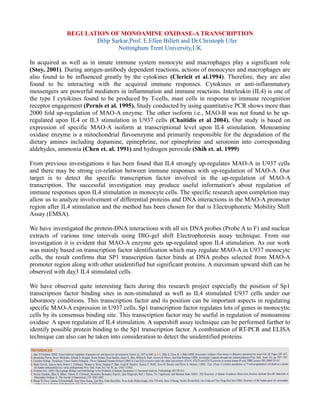Recommended
Recommended
More Related Content
What's hot
What's hot (20)
Lysosome an orchestrating, metabolic sensor during fasting

Lysosome an orchestrating, metabolic sensor during fasting
The symphony of the ninth, Th9 cells, by Dr.Pavulraj.S, veterinary pathologist

The symphony of the ninth, Th9 cells, by Dr.Pavulraj.S, veterinary pathologist
JAK-STAT and TGF-3/SMAD signal transduction pathways

JAK-STAT and TGF-3/SMAD signal transduction pathways
Viewers also liked
Viewers also liked (6)
A knowledge-based strategy for structural recognition of transcription factor...

A knowledge-based strategy for structural recognition of transcription factor...
Similar to abstract
Similar to abstract (20)
Krüppel-like factor 4 regulates macrophage polarization

Krüppel-like factor 4 regulates macrophage polarization
Investigating the function of a novel protein from Anoectochilus formosanus w...

Investigating the function of a novel protein from Anoectochilus formosanus w...
Transmembrane Enzyme Linked receptors Transmembrane JAK-STAT binding receptor...

Transmembrane Enzyme Linked receptors Transmembrane JAK-STAT binding receptor...
abstract
- 1. REGULATION OF MONOAMINE OXIDASE-A TRANSCRIPTION Dilip Sarkar,Prof. E.Ellen Billett and Dr.Christoph Ufer Nottingham Trent University,UK In acquired as well as in innate immune system monocyte and macrophages play a significant role (Stoy, 2001). During antigen-antibody dependent reactions, actions of monocytes and macrophages are also found to be influenced greatly by the cytokines (Clericit et al.1994). Therefore, they are also found to be interacting with the acquired immune responses. Cytokines or anti-inflammatory messengers are powerful mediators in inflammation and immune reactions. Interleukin (IL4) is one of the type I cytokines found to be produced by T-cells, mast cells in response to immune recognition receptor engagement (Pernis et al. 1995). Study conducted by using quantitative PCR shows more than 2000 fold up-regulation of MAO-A enzyme. The other isoform i.e., MAO-B was not found to be up- regulated upon IL4 or IL3 stimulation in U937 cells (Chaitidis et al 2004). Our study is based on expression of specific MAO-A isoform at transcriptional level upon IL4 stimulation. Monoamine oxidase enzyme is a mitochondrial flavoenzyme and primarily responsible for the degradation of the dietary amines including dopamine, epinephrine, nor epinephrine and serotonin into corresponding aldehydes, ammonia (Chen et. al. 1991) and hydrogen peroxide (Shih et. al. 1999) From previous investigations it has been found that IL4 strongly up-regulates MAO-A in U937 cells and there may be strong co-relation between immune responses with up-regulation of MAO-A. Our target is to detect the specific transcription factor involved in the up-regulation of MAO-A transcription. The successful investigation may produce useful information's about regulation of immune responses upon IL4 stimulation in monocyte cells. The specific research upon completion may allow us to analyze involvement of differential proteins and DNA interactions in the MAO-A promoter region after IL4 stimulation and the method has been chosen for that is Electrophoretic Mobility Shift Assay (EMSA). We have investigated the protein-DNA interactions with all six DNA probes (Probe A to F) and nuclear extracts of various time intervals using DIG-gel shift Electrophoresis assay technique. From our investigation it is evident that MAO-A enzyme gets up-regulated upon IL4 stimulation. As our work was mainly based on transcription factor identification which may regulate MAO-A in U937 monocyte cells, the result confirms that SP1 transcription factor binds at DNA probes selected from MAO-A promoter region along with other unidentified but significant proteins. A maximum upward shift can be observed with day3 IL4 stimulated cells. We have observed quite interesting facts during this research project especially the position of Sp1 transcription factor binding sites in non-stimulated as well as IL4 stimulated U937 cells under our laboratory conditions. This transcription factor and its position can be important aspects in regulating specific MAO-A expression in U937 cells. Sp1 transcription factor regulates lots of genes in monocytic cells by its consensus binding site. This transcription factor may be useful in regulation of monoamine oxidase A upon regulation of IL4 stimulation. A supershift assay technique can be performed further to identify possible protein binding to the Sp1 transcription factor. A combination of RT-PCR and ELISA technique can also can be taken into consideration to detect the unidentified proteins.
